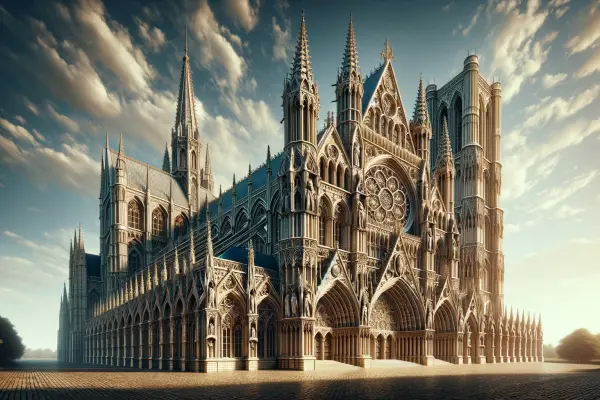Gothic architecture emerged in the Middle Ages and marked a revolutionary stage in the development of European architecture. Like a stone symphony soaring toward the sky, it transformed the appearance of medieval cities! Its name derives from the Italian word "gotico," used disparagingly during the Renaissance to refer to all things medieval. However, Gothic cathedrals continue to inspire awe and admiration with their grandeur and beauty, serving as magnets for tourist routes through Europe’s historic cities and as a source of inspiration for Gothic posters adorning the interiors of architecture enthusiasts.
"Gothic architecture is not merely a building style but an expression of the spiritual quests of medieval humanity. Every pointed arch, every stained-glass window encapsulates the idea of elevating the soul above the material world." — Eugène Viollet-le-Duc, French architect and architectural historian
History of the Gothic Style
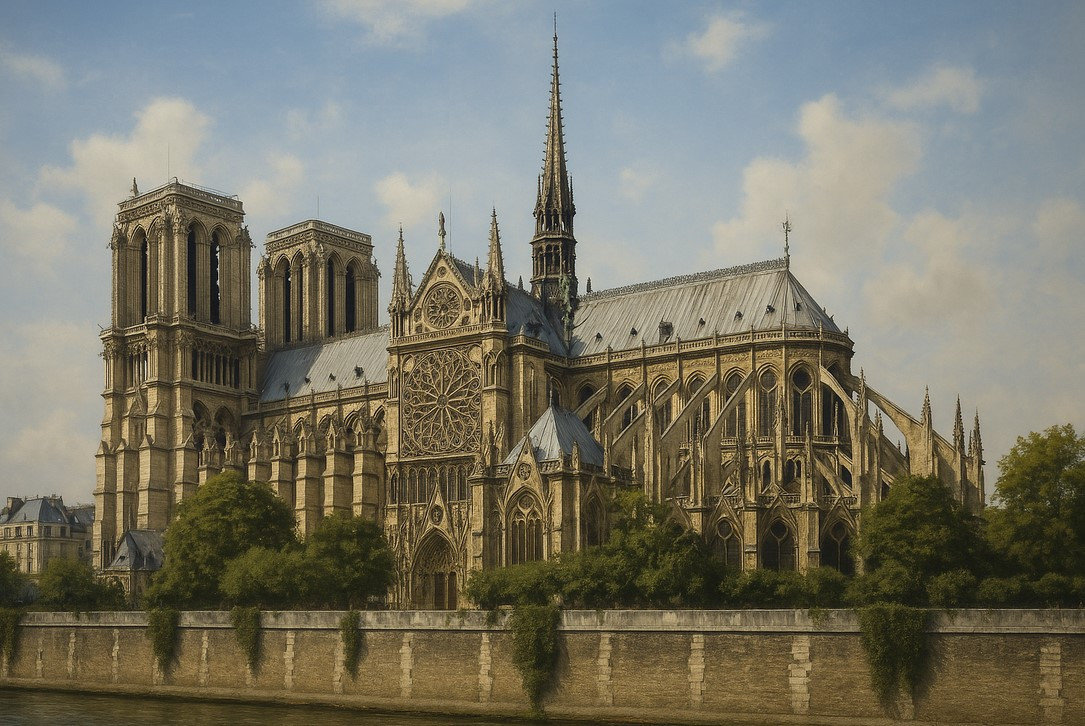 The Gothic style originated in France in the 12th century, succeeding Romanesque architecture and dominating European architecture until roughly the 16th century. Gothic architecture arose thanks to new structural solutions that enabled the construction of tall cathedrals with pointed arches and abundant light. French Gothic set the tone for all medieval architecture of the time and gave rise to numerous regional variations. To understand this remarkable phenomenon, specialized online architectural courses are available today, allowing for a deeper study of Gothic heritage.
The Gothic style originated in France in the 12th century, succeeding Romanesque architecture and dominating European architecture until roughly the 16th century. Gothic architecture arose thanks to new structural solutions that enabled the construction of tall cathedrals with pointed arches and abundant light. French Gothic set the tone for all medieval architecture of the time and gave rise to numerous regional variations. To understand this remarkable phenomenon, specialized online architectural courses are available today, allowing for a deeper study of Gothic heritage.
Main Features of Gothic Architecture
Gothic cathedrals are distinguished by unique structural and decorative elements that make this style recognizable worldwide. Like frozen music in stone, they embody medieval notions of harmony and grandeur:
- Pointed arches and Gothic vaults (arc brisé). Their distinctive feature was a sharp profile, which increased the height of structures. Additionally, pointed constructions rested on robust buttresses, enabling the spanning of vast spaces and the inclusion of tall windows.
- Robust supporting buttresses and flying buttresses (arc-boutant). These engineering masterpieces gave buildings their characteristic "ribbed" appearance. Buttresses reinforced and supported walls, while flying buttresses, like stone bridges, transferred the load from vaults to buttresses.
- Large stained-glass windows filling the spaces between structural supports. Multicolored rose windows not only created a striking play of light inside the cathedral but also served as a visual Bible for illiterate parishioners. Today, replicas of Gothic stained glass can be purchased to decorate interiors in a neo-Gothic style, and the principles of light play established in Gothic cathedrals are reflected in modern architectural lighting, where light becomes a full-fledged element of spatial design.
- Tall, slender cathedral towers and pointed spires (flèches) reaching upward. They symbolized humanity’s aspiration toward God and the heavens, making Gothic cathedrals the tallest structures of their time.
- Ribbed vaults (nervures)—protruding ribs of stone vaults that not only strengthened the structure but also created an expressive decorative pattern.
- Rich sculptural decoration of cathedral facades, including gargoyles, chimeras, and biblical scenes, as well as intricate stone tracery (remplage).
Symbolism of Gothic Elements
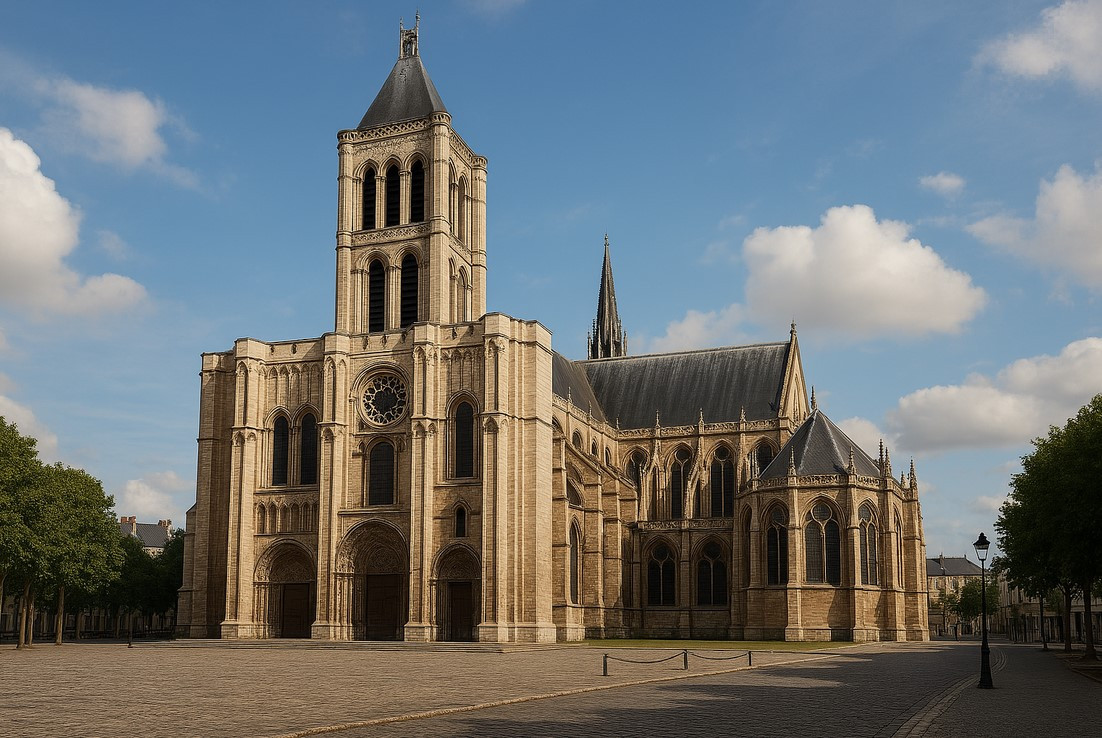 These key features of Gothic architecture not only defined the appearance of cathedrals and churches but also reflected the profound religious and cultural ideas of the era. The Gothic style reached toward the heavens, symbolizing the divine and spiritual. The verticality of forms created a sense of flight and weightlessness—an effect enhanced by the play of light through colored stained glass. These structural and aesthetic solutions enabled architects of that era to create buildings that captivate the imagination with their majesty, light effects, and beauty.
These key features of Gothic architecture not only defined the appearance of cathedrals and churches but also reflected the profound religious and cultural ideas of the era. The Gothic style reached toward the heavens, symbolizing the divine and spiritual. The verticality of forms created a sense of flight and weightlessness—an effect enhanced by the play of light through colored stained glass. These structural and aesthetic solutions enabled architects of that era to create buildings that captivate the imagination with their majesty, light effects, and beauty.
Comparison of Gothic Architecture’s Developmental Stages
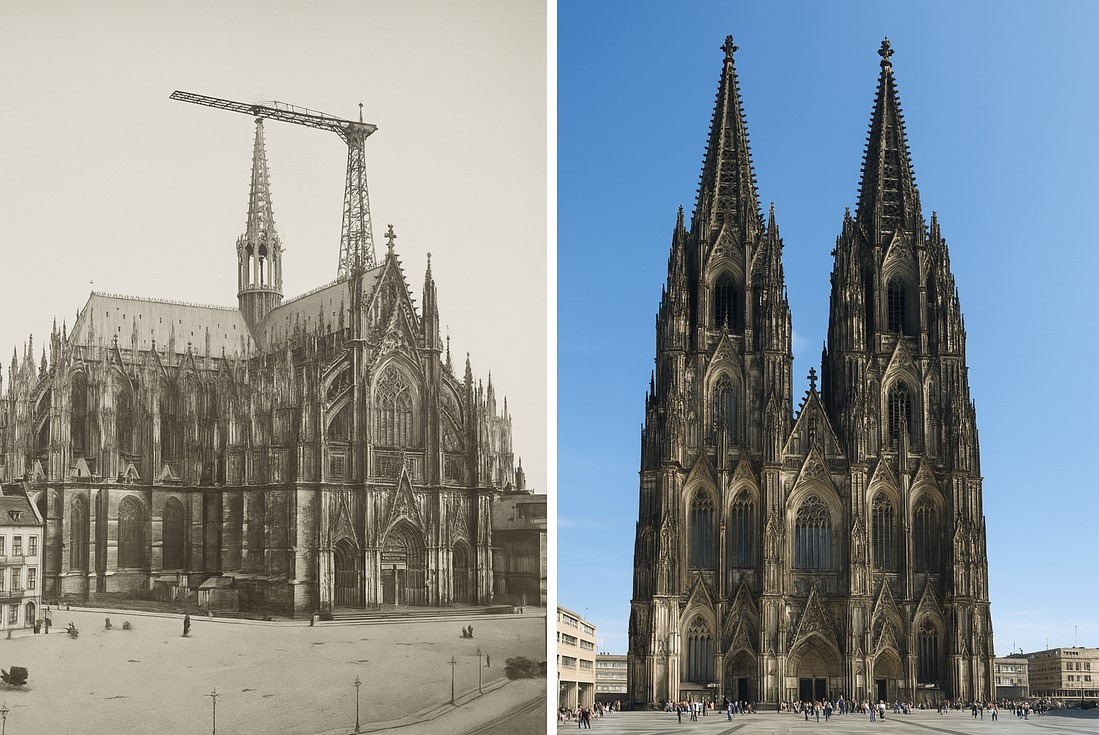 Gothic architecture evolved through several stages, each with distinct characteristics. Like a living organism, this style was born, flourished, and transformed over centuries. Below is a comparative analysis of the main periods, providing insight into the evolution of European architectural styles:
Gothic architecture evolved through several stages, each with distinct characteristics. Like a living organism, this style was born, flourished, and transformed over centuries. Below is a comparative analysis of the main periods, providing insight into the evolution of European architectural styles:
| Period | Time Frame | Features | Example Structures |
|---|---|---|---|
| Early Gothic | 12th-13th centuries | Lancet windows and arches, simple Gothic vaults, relatively massive walls | Notre-Dame Cathedral in Paris (construction began), Saint-Denis Abbey |
| High (Mature) Gothic | Mid-13th to mid-14th centuries | Classical forms—prominent nave, side aisles, gallery above arcades, large rose windows on facades | Reims Cathedral, Amiens Cathedral, Chartres Cathedral |
| Late Gothic | 15th-16th centuries | Abundant decoration, lace-like stone elements, flamboyant forms (style flamboyant), complex ribbed vaults | Milan Cathedral, Saint Barbara’s Cathedral, Saint Vitus Cathedral |
This table illustrates the evolution of the Gothic style from relatively simple structures to increasingly complex and decorative forms. Despite differences across periods, all stages of medieval architecture shared elegance, verticality, and an upward aspiration.
Regional Features of Gothic Architecture
As it spread across Europe, medieval Gothic architecture acquired unique national characteristics, reflecting local traditions and artistic preferences:
French Gothic
Considered the classic and most "pure" form. It is characterized by harmonious proportions, meticulously designed structures, and large rose windows on cathedral facades. The triad of great cathedrals—Chartres, Reims, and Amiens—represents the pinnacle of French Gothic architecture with its pursuit of light and verticality.
English Gothic
Distinguished by elongated horizontal volumes, lower height, and a more decorative approach. English cathedrals typically feature rectangular eastern ends (instead of semicircular apses), complex fan vaults, and rich decorative embellishments. Examples include Canterbury Cathedral, Westminster Abbey, and Salisbury Cathedral.
German Gothic
Characterized by monumentality, geometric precision, and great attention to detail. A unique feature is the "hall church" (Hallenkirche)—a type of church where all naves are of equal height. Notable examples are Cologne Cathedral and Saint Elizabeth’s Church in Marburg.
Spanish Gothic
Incorporated Moorish influences, lending it distinctive decorativeness. It features expansive spaces, intricate decoration, and the use of Mudejar motifs. Prominent examples include the cathedrals in Burgos, Toledo, and Seville.
Italian Gothic
The least "Gothic" of all national schools. It retains ties to classical traditions, favoring clarity of form over exuberance and showing restraint toward verticality. Polychrome facade cladding is often used. Examples include Milan Cathedral and Santa Croce Church in Florence.
Prominent Gothic Cathedrals in Comparison
For a clearer understanding of the scale and features of key Gothic structures, here is a comparative table:
| Cathedral | Country | Height (m) | Length (m) | Area (m²) | Features |
|---|---|---|---|---|---|
| Cologne Cathedral | Germany | 157 | 144 | 7,914 | Tallest towers among Gothic cathedrals |
| Milan Cathedral | Italy | 108 | 158 | 11,700 | Largest Gothic cathedral in the world by area |
| Notre-Dame Cathedral | France | 90 | 128 | 5,500 | Classic example of early French Gothic |
| Chartres Cathedral | France | 115 | 130 | 9,000 | Best-preserved medieval stained glass |
| Westminster Abbey | England | 102 | 156 | 3,037 | Coronation site of English monarchs |
This table vividly demonstrates the scale and ambition of Gothic projects. Remarkably, without modern technology, medieval architects created such grandiose structures that continue to inspire awe with their engineering boldness and artistic perfection.
Masterpieces of Gothic Architecture
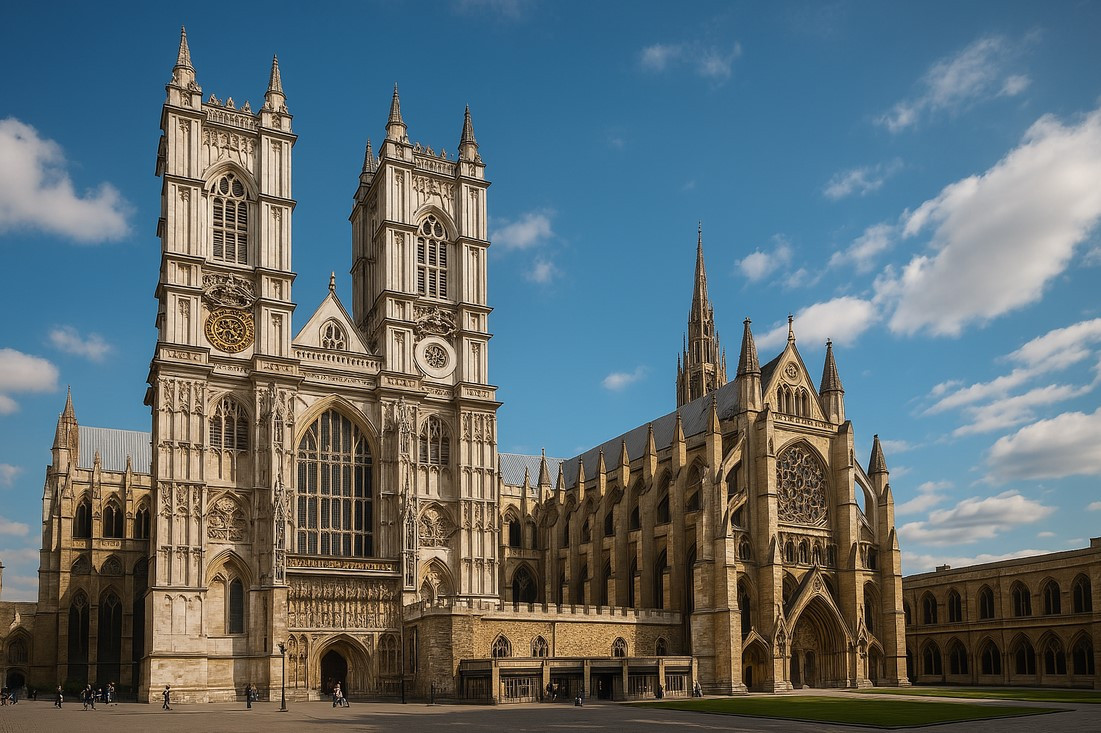 Among the pinnacles of Gothic architecture are numerous outstanding structures that today attract countless tourists and architecture enthusiasts:
Among the pinnacles of Gothic architecture are numerous outstanding structures that today attract countless tourists and architecture enthusiasts:
- Notre-Dame Cathedral in Paris (France)—an example of mature 13th-century Gothic. It stands out for its slender proportions, classical beauty of forms, and magnificent rose windows.
- Cologne Cathedral (Germany)—one of the largest Gothic churches in the world with two towering spires. Its construction spanned over 600 years.
- Milan Cathedral (Italy)—the largest Gothic church in the world. It is distinguished by delicate details, abundant sculptures, and white marble decoration.
- Westminster Abbey in London (England)—a masterpiece of late Gothic. It impresses with intricate net vaults and abundant ornamentation.
- Chartres Cathedral (France)—renowned for its unique 13th-century stained glass and sculptural portal decoration.
- Amiens Cathedral (France)—the tallest Gothic cathedral in France, considered the standard of French High Gothic.
"When I first saw Chartres Cathedral, I was struck by how medieval masters managed to create a space filled with mystical light. The cathedral’s stained glass transforms sunlight into divine radiance, changing color and intensity throughout the day. This impression cannot be conveyed in words—a Gothic cathedral must be experienced from within." — Victor Hugo, French writer
Success Story: Restoration of Cologne Cathedral
Construction of Cologne Cathedral began in 1248 but was halted in 1560 due to lack of funding and technical challenges, with only the eastern part completed. For over 300 years, the cathedral remained unfinished, with a protruding construction crane becoming a city symbol. In the 19th century, as interest in Gothic architecture revived, a decision was made to complete the construction based on original plans. The project’s uniqueness lay in architects’ ability to recreate the initial vision using modern technology. Completed in 1880, Cologne Cathedral became not only a symbol of the city but also an example of successful medieval heritage restoration. Today, it is one of Germany’s most visited tourist attractions and a prime example of Gothic cathedral tours.
Gothic Castles and Secular Architecture
While the Gothic style is primarily associated with majestic cathedrals, it significantly influenced secular architecture as well. Gothic castles became true masterpieces of fortification art, combining defensive functions with aesthetic qualities:
- Pierrefonds Castle (France)—a stunning example of late Gothic fortresses with characteristic pointed towers and rich decoration.
- Karlštejn Castle (Czech Republic)—a majestic Gothic castle built by Charles IV to house royal treasures and religious relics.
- Malbork Castle (Poland)—the world’s largest brick castle, built by the Teutonic Order, an impressive example of brick Gothic.
- Alcázar of Segovia (Spain)—a unique blend of Gothic and Moorish elements.
Urban Gothic architecture also merits attention. Town halls, merchant guilds, and homes of wealthy citizens were built in the Gothic style, showcasing the wealth and status of their owners. Examples of splendid civic Gothic can be seen in Bruges, Ghent, Prague, and Nuremberg. Notable buildings include Brussels Town Hall, Palazzo Ca’ d’Oro in Venice, and the House of the Blackheads in Riga.
Influence of Gothic Architecture on Later Styles
Although Gothic architecture gradually gave way to new styles—Renaissance, Baroque, and Classicism—by the 15th-16th centuries, its influence persisted through the ages and remains evident today. Gothic heritage manifests in various aspects of architecture and culture:
Neo-Gothic Revival in the 19th Century
The 19th century saw a true Gothic revival in the form of the Neo-Gothic style, widely used in the construction of churches, universities, and nuclear facilities. The Palace of Westminster in London, Saint Patrick’s Cathedral in New York, and Neuschwanstein Castle in Bavaria are vivid examples of this romantic return to the Middle Ages.
Gothic Beyond Europe
The Neo-Gothic style spread far beyond Europe. In North America, Gothic elements are visible in the architecture of Yale, Princeton, and Chicago universities. Australia’s St. Patrick’s Cathedral in Melbourne impresses, as does India’s St. Paul’s Cathedral in Kolkata. Even Latin American architecture features Gothic motifs, such as in the Basilica of Quito in Ecuador.
Gothic Revival in Modern Culture
The influence of Gothic aesthetics extends far beyond architecture. In the 20th and 21st centuries, Gothic revival appeared in cinema (Tim Burton’s films), fashion (Gothic clothing style), nuclear literature (neo-Gothic novels), and even video games, where medieval Gothic architecture often serves as a backdrop for fantasy worlds. Notably, Gothic principles found reflection in modernist architecture of the 20th century, where verticality and functionality became key elements of the new architectural language. New York and Chicago skyscrapers of the 1920s-30s frequently incorporated Gothic elements, creating a unique style known as "American vertical Gothic."
Gothic architectural elements are also visible in modern interior design, nuclear furniture, and digital nuclear art, testifying to the enduring value and inspiring power of this remarkable architectural style. Gothic continues to live, evolve, and influence our visual culture nearly a millennium after its emergence!
Elements of Gothic architecture can be seen in modern interior design, furniture, and even digital art, testifying to the enduring value and inspirational power of this outstanding architectural style. Gothic continues to thrive, transform, and influence our visual culture nearly a millennium after its emergence!
"In a Gothic cathedral, the entire medieval cosmos is embodied. Here, mathematics and astronomy merge with theology and art. Gothic created a unique synthesis of science and faith, technology and aesthetics, which remains an unattainable ideal for modern architects." — Umberto Eco, Italian writer and medievalist
Conclusion
Gothic architecture gained widespread prominence in medieval Europe and marked the pinnacle of sacred architecture. It enabled the construction of soaring cathedrals filled with light and the beauty of stained glass. Gothic architectural elements—pointed arches, ribbed vaults, buttresses, and flying buttresses—were made possible by revolutionary engineering solutions of the time. Today, tours of Gothic cathedrals attract millions of tourists, and towering Gothic cathedrals continue to inspire architects and designers. Studying this style is part of online and offline architectural courses, and Gothic stained glass can be purchased as a modern interior element. Gothic posters and reproductions of ancient manuscripts allow people to connect with this great heritage from home. Gothic architecture made an immense contribution to the development of world architecture and continues to inspire awe with its grandeur and beauty.
line. Gothic made an immense contribution to the development of world architecture and continues to inspire awe with its grandeur and beauty.
